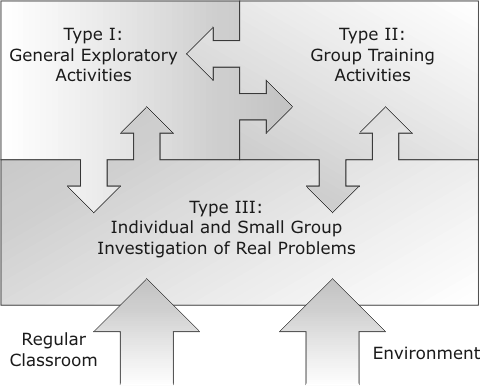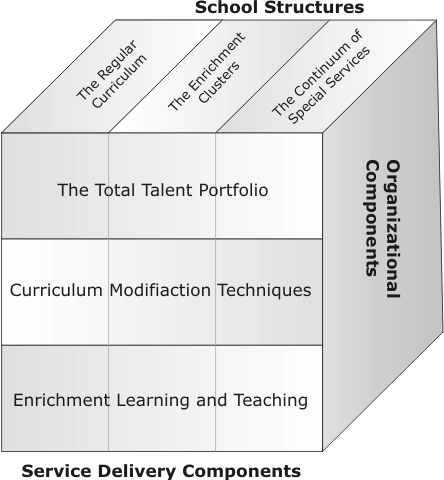schoolwide enrichment model
Dr. Joseph Renzulli and his colleagues at University of Connecticut spent 15 years developing, researching, and testing this comprehensive gifted education curriculum model. This strategy typically involves the cooperation of the entire staff and administration of a school. However, a regular classroom teacher can use elements of Schoolwide Enrichment Model (SEM) in his or her classroom with the entire class or a select group of students.
If your school choses to adopt SEM, they will be committing to providing enriching and challenging learning activities to all students. SEM can be explained by describing the triad of learning approaches. Type I activities, General Exploratory Activities, are available for all students in the school. These activities include field trips, speakers, assemblies, plays, etc. The goal of Type I activities is to provide an expert's opinion on a certain subject. All students benefit from this type of activity, because they are having an authentic experience.
Type II activities, or Group Training Activities, take a Type I experience further by exploring a problem or issue in groups. Most often, this is manifested in elementary schools through enrichment clusters. Each school designs its enrichment cluster system differently, but Renzulli recommends that the students be able to choose which enrichment cluster interests them most, that enrichment clusters meet on a regular basis, and that enrichment clusters have a purpose that results in some kind of product. Ideally, all students in the school would be able to participate in enrichment clusters, but these can be modified and used with select groups of students.
Type III activities, Individual and Small Group Investigation of Real Problems, are usually reserved for students identified as gifted or those students who have shown potential for the gifted program and have high motivation. During Type III work, students chose a problem to focus on. By themselves or in small groups, students must research their problem, decide on a product to create that will demonstrate a possible solution to that problem, and present their product to an appropriate audience. Type III projects can take up to an entire school year to complete. Students are usually given a set amount of time per day or week to devote to their Type III projects. Students are allowed to spend their time learning about a subject in which they are interested while learning valuable interpersonal, research, organization, and time management skills.
Regular classroom teachers can infuse any or all of these elements in their own classroom. The classroom teacher can seek out Type I speakers in the community to come into the classroom and talk about a topic the class is studying. For example, if a second grade class is talking about the life cycle of a cat, perhaps a veterinarian could come talk to the class about what might effect that life cycle. Regular classroom teachers can also chose to allow their classes or groups of gifted students to participate in Type II activities as they relate to certain topics being studied. For example, gifted students who have mastered the material being taught could create an enrichment cluster about that topic that seeks to solve a specific problem. Those students could work with the teacher during specific time periods on a challenging project. Finally, a regular classroom teacher can easily incorporate Type III activities into the classroom. Gifted students can complete a Type III Project with autonomy once they are given the tools needed (research, organization, creative thinking skills). It is possible for the regular classroom teacher to teach either the gifted students or the entire class mini-lessons on these skills before allowing the gifted students to work on Type III projects while the rest of the class works on the regular curriculum.
If your school choses to adopt SEM, they will be committing to providing enriching and challenging learning activities to all students. SEM can be explained by describing the triad of learning approaches. Type I activities, General Exploratory Activities, are available for all students in the school. These activities include field trips, speakers, assemblies, plays, etc. The goal of Type I activities is to provide an expert's opinion on a certain subject. All students benefit from this type of activity, because they are having an authentic experience.
Type II activities, or Group Training Activities, take a Type I experience further by exploring a problem or issue in groups. Most often, this is manifested in elementary schools through enrichment clusters. Each school designs its enrichment cluster system differently, but Renzulli recommends that the students be able to choose which enrichment cluster interests them most, that enrichment clusters meet on a regular basis, and that enrichment clusters have a purpose that results in some kind of product. Ideally, all students in the school would be able to participate in enrichment clusters, but these can be modified and used with select groups of students.
Type III activities, Individual and Small Group Investigation of Real Problems, are usually reserved for students identified as gifted or those students who have shown potential for the gifted program and have high motivation. During Type III work, students chose a problem to focus on. By themselves or in small groups, students must research their problem, decide on a product to create that will demonstrate a possible solution to that problem, and present their product to an appropriate audience. Type III projects can take up to an entire school year to complete. Students are usually given a set amount of time per day or week to devote to their Type III projects. Students are allowed to spend their time learning about a subject in which they are interested while learning valuable interpersonal, research, organization, and time management skills.
Regular classroom teachers can infuse any or all of these elements in their own classroom. The classroom teacher can seek out Type I speakers in the community to come into the classroom and talk about a topic the class is studying. For example, if a second grade class is talking about the life cycle of a cat, perhaps a veterinarian could come talk to the class about what might effect that life cycle. Regular classroom teachers can also chose to allow their classes or groups of gifted students to participate in Type II activities as they relate to certain topics being studied. For example, gifted students who have mastered the material being taught could create an enrichment cluster about that topic that seeks to solve a specific problem. Those students could work with the teacher during specific time periods on a challenging project. Finally, a regular classroom teacher can easily incorporate Type III activities into the classroom. Gifted students can complete a Type III Project with autonomy once they are given the tools needed (research, organization, creative thinking skills). It is possible for the regular classroom teacher to teach either the gifted students or the entire class mini-lessons on these skills before allowing the gifted students to work on Type III projects while the rest of the class works on the regular curriculum.
sample lesson
This is an overview of some of the lessons that a second grade classroom using the Schoolwide Enrichment Model will be using over the year in various subjects.
Resources
Revisiting the Schoolwide Enrichment Model
Mountain Park Elementary School's Use of SEM
Spotlight on J.J. Harris Elementary, a Gifted Charter School using SEM
Mountain Park Elementary School's Use of SEM
Spotlight on J.J. Harris Elementary, a Gifted Charter School using SEM
references
Giger, M. (April 2006). Type I to III Enrichment. In Gigers.com. Retrieved April 18, 2013 from
http://www.gigers.com/matthias/gifted/sem-enrichment.html.
(July 2011). Schoolwide Enrichment Model. In Mountain Park Elementary School. Retrieved April 12, 2013 from https://sites.google.com/site/mpemustangs/schoolwide-enrichment-model.
http://www.gigers.com/matthias/gifted/sem-enrichment.html.
(July 2011). Schoolwide Enrichment Model. In Mountain Park Elementary School. Retrieved April 12, 2013 from https://sites.google.com/site/mpemustangs/schoolwide-enrichment-model.


